-
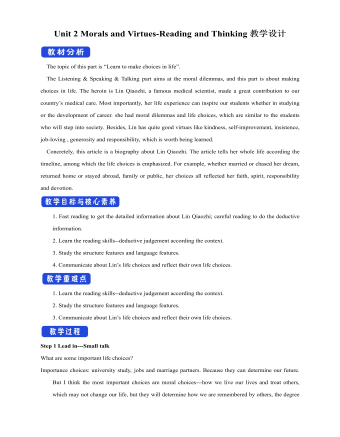
新人教版高中英语必修3Unit 2 Morals and Virtues-Reading and Thinking教学设计
The topic of this part is “Learn to make choices in life”.The Listening & Speaking & Talking part aims at the moral dilemmas, and this part is about making choices in life. The heroin is Lin Qiaozhi, a famous medical scientist, made a great contribution to our country’s medical care. Most importantly, her life experience can inspire our students whether in studying or the development of career. she had moral dilemmas and life choices, which are similar to the students who will step into society. Besides, Lin has quite good virtues like kindness, self-improvement, insistence, job-loving , generosity and responsibility, which is worth being learned.Concretely, this article is a biography about Lin Qiaozhi. The article tells her whole life according the timeline, among which the life choices is emphasized. For example, whether married or chased her dream, returned home or stayed abroad, family or public, her choices all reflected her faith, spirit, responsibility and devotion.1. Fast reading to get the detailed information about Lin Qiaozhi; careful reading to do the deductive information.2. Learn the reading skills--deductive judgement according the context.3. Study the structure features and language features. 4. Communicate about Lin’s life choices and reflect their own life choices.1. Learn the reading skills--deductive judgement according the context.2. Study the structure features and language features.3. Communicate about Lin’s life choices and reflect their own life choices.Step 1 Lead in---Small talkWhat are some important life choices?Importance choices: university study, jobs and marriage partners. Because they can determine our future.

新人教版高中英语必修3Unit 4 Space Exploration-Listening&Speaking&Talking教学设计一
Listening and Speaking introduces the topic of “talking about how to become an astronaut”. This period is aimed to inform students some details about the requirements of being an astronaut. Students can be motivated and inspired by the astronauts. Teachers ought to encourage students to learn from them and let them aim high and dream big.Listening and Talking introduces the theme of "talk about life in space". This part also informs students more details about life in space and can inspire students to be curious about this job. 1. Guide students to listen for numbers concerning dates, years and ages etc2. Cultivate students' ability to talk about how to become an astronaut and life in space ; 3. Instruct students to use functional sentences of the dialogue such as “ first of all, I am not sure, so what might be .. I guess.. I wonder…I am curious…)appropriately.1. Guide students to understand the content of listening texts in terms of the whole and key details; 2. Cultivate students' ability to guess the meaning of words in listening; discuss with their peers how to become a qualified astronaut and describe the life in space.Part 1: Listening and SpeakingStep 1: Lead inPredictionThe teacher can ask students to predict what the listening text is about by looking at the pictures.About how to become an astronaut./the requirements of an astronautStep 2: Then, play the radio which is about an interview a. And after finishing listening for the first time, the students need to solve the following tasks.

新人教版高中英语必修3Unit 4 Space Exploration-Discovering Useful Structure教学设计
The theme of the section is “Describe space facts and efforts to explore space”. Infinitives are one of non-finite verbs, as the subjects, objects, predicative, attributes and adverbials. This unit is about space exploration, which is a significant scientific activity, so every scientific activity has strong planning. Therefore, using the infinitives to show its purpose, explanations or restrictions is the best choice.1. Learn the structure, functions and features of infinitives.2. Learn to summarize some rules about infinitives to show purpose and modify.3. Learn to use infinitives in oral and writing English. 1. Learn the structure, functions and features of infinitives.2. Learn to summarize some rules about infinitives to show purpose and modify.3. Learn to use use infinitives in oral and writing English.Step 1 Lead in---Pair workLook at the following sentences and focus on the italicized infinitives. In pairs, discuss their functions. 1. I trained for a long time to fly airplanes as a fighter pilot..(作目的状语)2. As we all know, an astronaut needs to be healthy and calm in order to work in space..(作目的状语)3. First of all, you must be intelligent enough to get a related college degree..(作目的状语)4. Some scientist were determined to help humans realise their dream to explore space..(作定语)5. On 12 April 1961, Yuri Gagarin became the first person in the world to go into space..(作定语)Summary:1. 不定式的结构:to+do原形。2. 分析上面的句子,我们知道在描述太空探索时,动词不定式不仅可以用来表目的,还可以用来作定语,表修饰。
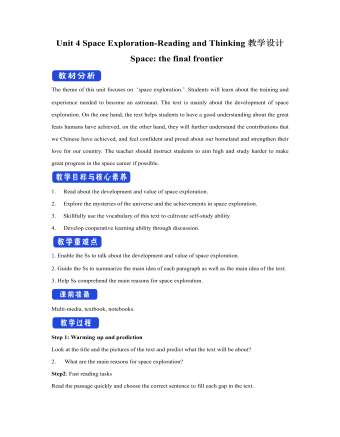
新人教版高中英语必修3Unit 4 Space Exploration-Reading and Thinking教学设计二
The theme of this unit focuses on “space exploration.” Students will learn about the training and experience needed to become an astronaut. The text is mainly about the development of space exploration. On the one hand, the text helps students to have a good understanding about the great feats humans have achieved, on the other hand, they will further understand the contributions that we Chinese have achieved, and feel confident and proud about our homeland and strengthen their love for our country. The teacher should instruct students to aim high and study harder to make great progress in the space career if possible.1. Read about the development and value of space exploration.2. Explore the mysteries of the universe and the achievements in space exploration.3. Skillfully use the vocabulary of this text to cultivate self-study ability 4. Develop cooperative learning ability through discussion.1. Enable the Ss to talk about the development and value of space exploration.2. Guide the Ss to summarize the main idea of each paragraph as well as the main idea of the text.3. Help Ss comprehend the main reasons for space exploration. Multi-media, textbook, notebooks.Step 1: Warming up and predictionLook at the title and the pictures of the text and predict what the text will be about?2. What are the main reasons for space exploration?
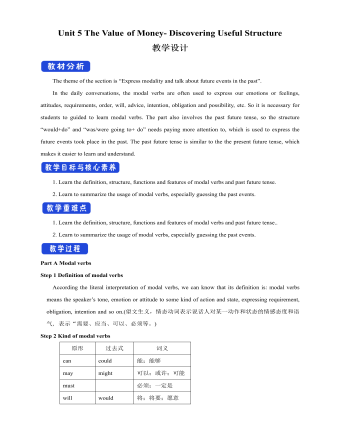
新人教版高中英语必修3Unit 5 The Value of Money- Discovering Useful Structure教学设计
Step 3 Meaning1. 过去将来时表示从过去某一时间来看将要发生的动作或存在的状态, 常用在宾语从句中。一般由“would/should +动词原形”构成。She hoped that they would meet again someday. 她希望将来有一天他们能再见面。2. was/were going to+动词原形: 表示过去将要发生或很有可能发生的动作, 常用于口语中, 表示预言、意图或者打算等。He was going to start work the following week. 他打算下星期开始工作。3. was/were about to do: 常用来表示即将发生的动作, “刚要/正要做……”。注意该结构不与任何时间状语连用。I felt that something terrible was about to happen. 我感到某种可怕的事情即将发生。4.was/were to do: 表示“曾计划做某事”, 如果表示“本来计划做某事, 动作没实现”, 则需用 “was/were to have done”。She said she was to have told me about the accident. 她说她本来想告诉我关于事故的事。5.Start, go, come, leave, see, meet等动词的过去进行时: 表示就过去某一时刻而言即将发生的动作。She was coming later. 她随后就来。I had just put on my overcoat and was leaving to visit a friend of mine. 我刚穿上外套要去看我的一个朋友。
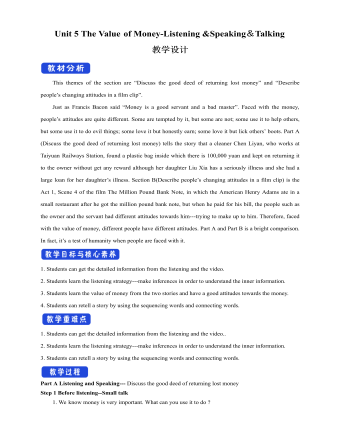
新人教版高中英语必修3Unit 5 The Value of Money-Listening &Speaking&Talking教学设计
4. A:We’d like to have someone to say a word at the beginning to welcome the group.B:↙Who?A:We thought that you or Dr.Johnson might do it.B用降调说Who,其意思是问,对方想让谁在开场时致欢迎词。Step 6 Pronunciation---Practice1. Listen to the short conversation and mark the intonation with ↗, ↙ or ↙, ↗. Then discuss with a partner what they intend to convey by using different intonation.Owner: You know what ?↗ It’s a million-pound bank note↙.Waiter 1: Really ?↗(question)Waiter 2: Really !↙(unbelievable and surprised)Waiter 3: Really ?!↙↗(first question then surprised)2. Listen to the conversations. Underline the parts that are stressed and mark the intonation. Then talk about the implied meanings of the responses with different intonations. Listen again and repeat.1) Henry: It’s a nice suit.Owner: Oh, it’s perfect!↙(The intonation means it is very suitable for Henry.)2) Henry: Well, that’s very kind of you.Owner: Kind, sir ?↗(what you said is not right) No, it’s kind of you. You must come whenever you want and have whatever you like. Just having you sit here is a great honour !!↙(welcome you to come again)3)Henry:Well, to be honest, I have none. Oliver:(happily) What luck!(excited) Brother↗, what luck!↙(It means “Didn’t you hear it?”)Henry: Well, it may seem lucky to you but not to me!↗(angry) If this is your idea of some kind of joke, I don’t think it’s very funny. Now if you’ll excuse me, I ought to be on my way.↙(If so, I would leave.)Roderick: Please don’t go↙...(hope Henry can wait for a moment)Part B Viewing and Talking---Describe people’s changing attitudes in a film clipStep 1 Before-listening---Tell the filmYou are going to watch part of the film The Million Pound Bank Note. Look at these photos and guess what happens in the film.

新人教版高中英语必修3Unit 5 The value of money-Reading and Thinking教学设计二
? Could you offer me some kind of work here?? I don’t want your charity, I just want an honest job.? Careless: I landed in Britain by accident.Step 7:Consolidation.? Find Henry? Roderick and Oliver were I .making a bet when they saw Henry, a poor young man. ? Know Henry? About a month ago, Henry was sailing and later he found himself carried out to sea by a strong wind. Fortunately, he 2.was spotted by a ship. And it was the ship that brought him to 3.England? Offer money to Henry ? Oliver and Roderick gave Henry a letter and told him that there was money in it. They 4.persuaded him to accept it, and made him 5.promise that it wouldn't be opened until 2 o'clock.Step 8:Language pointsa large amount of: a large quantity of; a great deal ofe.g. They bought a large amount of furniture before they moved their new house.make a bet: make an arrangement to risk money, etc. on an event of which the result is doubtful.e.g. We made a bet on the result of the match.permit sb to do something: allow somebody to do somethinge.g. My mother doesn’t permit me to ride in the street after it rained.by accident: as a result of chancee.g. I only found it by accident.stare at: look at somebody or something with the eyes wide open in a fixed gaze( in astonishment, wonder, fear, etc)to be honest: to tell you the truth; to be franke.g. To be honest, I don’t think we have a chance of winning.Step7 Homework:What do you think will happen to Henry? Will the bank-note help him or get him into trouble?
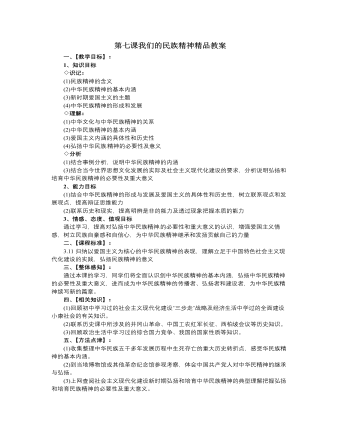
人教版高中政治必修3第七课我们的民族精神精品教案
4.弘扬和培育中华民族精神,是坚持社会主义道路的需要在这里重点把握坚持社会主义道路为什么必须弘扬和培育民族精神这一知识点。由于中国走的是社会主义道路,而西方敌对势力不愿意看到社会主义中国发展壮大,加紧以各种手段和方式对我国实施西化、分化的政治战略。面对这种挑战,要顶住霸权主义的种种压力,抵制外来腐朽思想文化的影响,弘扬和培育民族精神显得更为重要和迫切。◇拓展延伸:当今世界,不同社会制度意识形态之间的斗争在一定范围内将长期存在,斗争的一种重要表现就是西方敌对势力对社会主义的中国实施西化、分化的政治战略。因此,必须通过弘扬和培育民族精神来坚定人们的社会主义信念,抵制外来腐朽思想文化的侵蚀。◇课堂练习:面对西方敌对势力对我国实施的西化、分化,我们必须()①大力弘扬和培育民族精神②加快社会主义现代化建设步伐,坚定人们的社会主义信念③借鉴西方文化中的先进成分④加强社会主义道德建设,提高抗侵蚀能力A.①②③B.②③④C.①②④D.①②③④
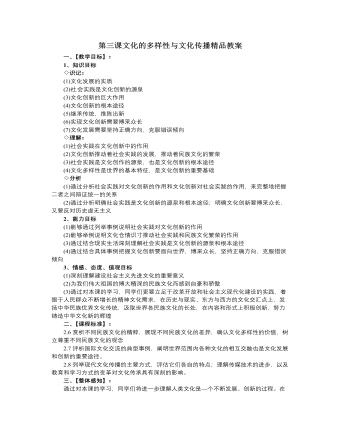
人教版高中政治必修3第三课文化的多样性与文化传播精品教案
◇探究提示:我们可以通过人际交往,阅读报纸、杂志、书籍等,欣赏电视、上网查询、发送手机短信、阅读电子读物等方式来搜集资料。其特点为:人际传播是社会生活中最直观、最常见、最丰富的传播现象,具有传播渠道多、方法灵活、意义丰富、反馈及时的特点。报纸、杂志、书籍等,可以通过扫描、编排处理后,显示在互联网上,供广大读者使用。电视提供了动态画面和缤纷的色彩,使人们对信息的理解变得更生动、形象和真实。互联网具有传播同网、全球同时、受众主动、双向互动的特点。手机短信用精练的语言传达丰富多彩的内容,不仅具有娱乐性,还具有情感性、艺术性耙哲理性,让人回味无穷。电子读物实现了文字、图像、声音的完关结合,使人在看图阅文的同时可以听音乐、写文章、做笔记、复制文件等等。
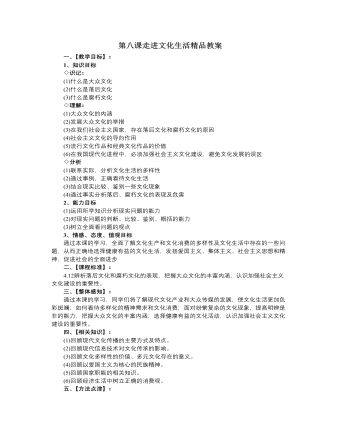
人教版高中政治必修3第八课走进文化生活精品教案
1.加强社会主义文化建设的必要性在人类历史的长河中,各种思想文化总是相互冲击、交汇、融合.奔腾向前,永不停息。今天,我们面对的文化有传统的和现代的、外来的和本土的、进步的和落后的、先进的和腐朽的、积极的和颓废的,等等。各种各样的文化有吸纳又有排斥,有融合又有斗争,有渗透又有抵御,呈现出前所未有的相互交织、相互激荡之势。在这种文化发展的大背景下,在我国现代化建设过程中,有必要弘扬我国社会主义的主流文化,这样有利于保证我国社会主义文化发展的方向。2.大力加强社会主义文化建设(1)中国特色社会主义文化在我国文化生活中处于主导地位。中国特色社会主义文化,始终坚持以科学的理论武装人,以正确的舆论引导人,以高尚的精神塑造人,以优秀的作品鼓舞人,无论是思想内容还是表现形式,都发挥着强有力的导向和示范作用。社会主义文化以其自身的科学性和先进性,并依靠社会主义政治和经济力量,在人民大众的文化生活中始终占据着主导地位。
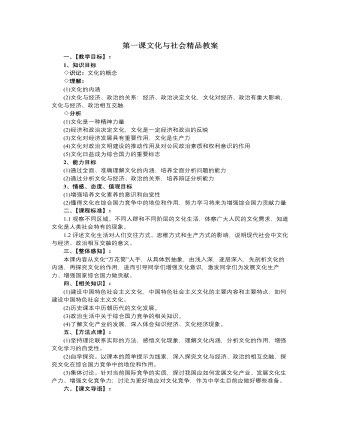
人教版高中政治必修3第一课文化与社会精品教案
(2)历史课本中历朝历代的文化发展。(3)政治生活中关于综合国力竞争的相关知识。(4)了解文化产业的发展,深入体会知识经济、文化经济现象。五、【方法点津】:(1)坚持理论联系实际的方法,感悟文化现象,理解文化内涵,分析文化的作用,增强文化学习的自觉性。(2)自学探究。以课本的简单提示为线索,深入探究文化与经济、政治的相互交融,探究文化在综合国力竞争中的地位和作用。(3)集体讨论。针对当前国际竞争的实质,探讨我国应如何发展文化产业、发展文化生产力、增强文化竞争力;讨沦为更好地应对文化竞争,作为中学生目前应做好哪些准备。六、【课文导语】:文化,一个我们十分熟悉的词汇。然而“熟知并非真知”。有人说,文化是知识;有人说,文化是艺术。究竟什么是“文化”?只要在社会生活中细细体味,我们就能真切地感悟“文化”的内涵与文化的力量。

人教版高中政治必修3第四课文化的继承性与文化发展精品教案
◇探究提示:(1)孔子思想体系的核心是“仁’’和“礼”,其主要内容是“仁者爱人”和“克己复礼”。孔子提出“仁”的学说,要求统治者体察民情,反对苛政和任意刑杀;提倡广泛地理解、体贴他人,以此调整人际关系,稳定社会秩序。孔子讲的“克己复礼”,是说做人要克制自己,使自己的行为符合‘‘礼’’的要求。(2)老子认为“道”是凌驾于天之上的天地万物的本原,他提出‘‘天法道,道法自然”的思想。老子从“天道自然无为”的思想出发,倡导政治上“无为而治”,以“无事取天下”。老子哲学中包含着丰富的辩证法思想,他指出,任何事物都有矛盾、对立的两个方面,矛盾双方可以相互转化。(3)墨子主张“兼爱”“非攻”,“兼爱”就是无等差的爱,无论任何人,都不分轻重厚薄;“非攻”就是反对不义的兼并战争,主张各国和平相处。(4)韩非子崇尚法,强调法的重要性,主张法、术、势相结合,建立一个君主专制的中央集权国家,要求人人必须遵守法;韩非子还认为社会不断发展变化,历史永远不会倒退,主张变法革新。
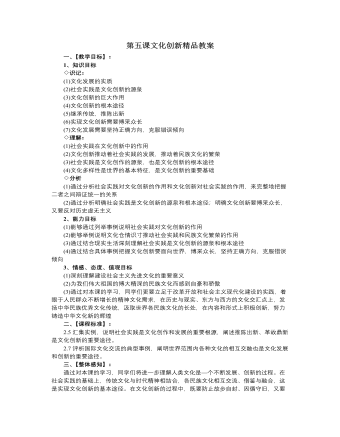
人教版高中政治必修3第五课文化创新精品教案
3.社会实践对文化创新的决定作用社会实践对文化创新具有两个方面的重要作用:(1)社会实践是文化创新的源泉实践,作为人们改造客观世界的活动,是一种有目的、有意识的社会性活动。人类在改造自然和社会的实践中,创造出自己特有的文化。离开了社会实践;文化就会成为无源之水、无本之木,人们不可能从事任何有价值的文化创造。◇本课小结:1.关于本课逻辑结构的宏观把握:文化创新的源泉和作用这一问题,教材分三个层次展开论证:一是不尽的源泉,不竭的动力;二是巨大的作用,深刻的意义;三是呼唤文化创新的时代。教材运用辩证方法从文化创新的源泉和作用展开论述。即社会实践是文化创新的源泉,文化创新又推动社会实践的发展和促进民族文化的繁荣。教材关于文化创新的途径问题,从三个层次展开讲述:第一个层次是“继承传统,推陈出新”;第二个层次是“面向世界,博采众长”;第三个层次是“坚持正确方向,克服错误倾向”。
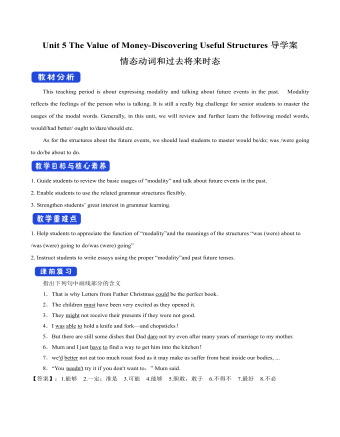
新人教版高中英语必修3Unit 5 The Value of Money-Discovering Useful Structures导学案
4.They were going to find someone to take part in their bet when they saw Henry walking on the street outside.[归纳]1.过去将来时的基本构成和用法过去将来时由“would+动词原形”构成,主要表示从过去某一时间来看将要发生的动作(尤其用于宾语从句中),还可以表示过去的动作习惯或倾向。Jeff knew he would be tired the next day.He promised that he would not open the letter until 2 o'clock.She said that she wouldn't do that again.2.表示过去将来时的其他表达法(1)was/were going to+动词原形:该结构有两个主要用法,一是表示过去的打算,二是表示在过去看来有迹象表明将要发生某事。I thought it was going to rain.(2)was/were to+动词原形:主要表示过去按计划或安排要做的事情。She said she was to get married next month.(3)was/were about to+动词原形:表示在过去看来即将要发生的动作,由于本身已含有“即将”的意味,所以不再与表示具体的将来时间状语连用。I was about to go to bed when the phone rang.(4)was/were+现在分词:表示在过去看来即将发生的动作,通常可用于该结构中的动词是come,go,leave,arrive,begin,start,stop,close,open,die,join,borrow,buy等瞬间动词。Jack said he was leaving tomorrow.
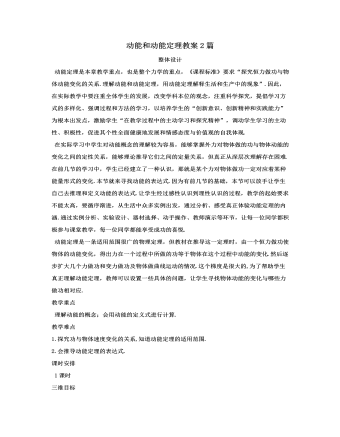
人教版新课标高中物理必修2动能和动能定理教案2篇
二、课堂教学(课前由科代表发回预习学案)1、教师根据预习学案检查结果提出问题(用多媒体展示),引导全班讨论(重点讨论:①、为什么动能的表达式一定是 mV2 ?你如何得出这个结论?②、力在一个过程中对物体所做的功,和物体在这个过程中动能的变化量有什么关系?你如何得出这个结论?这个做功的力和F=ma中的力F有什么关系)。有困难的小组应及时问老师。老师在这个过程中巡视指导。2、学生自主阅读课文“7 动能和动能定理”中的“动能的表达式”,然后完成如下练习(教师在此过程中巡视指导):2.1尝试推出动能的表达式(鼓励会推导的同学积极上台板演,老师引导讨论)。2.2写出动能的小结(认真阅读教材p66倒数第二段、第三段,结合你推导动能表达式的过程,认真思考后四人一组讨论:①、动能是矢量还是标量?②、动能的单位是什么?③、你认为应从哪几方面来理解动能?)
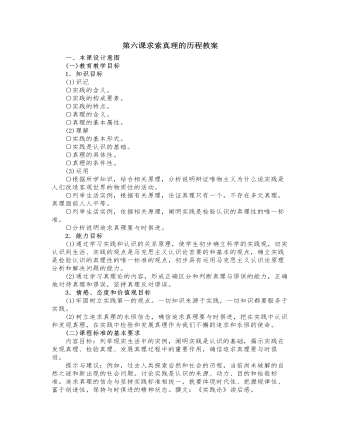
人教版高中政治必修4第六课求索真理的历程教案
农业科学的周期是以年为时间单位,一次实验就要等到一次花开、结果。就这样,几个实验误导了袁隆平好几年。这时登在《参考消息》上的一篇不起眼的文章像给迷途中的袁隆平以当头一棒:克里克、沃森和威尔金斯发现DNA螺旋结构,西方的遗传学研究进入分子水平。“我当时还在那里搞什么无性杂交,糟糕得很”。水稻是自花授粉植物,雄蕊雌蕊都在一朵花里面,雌雄同株,没有杂种优势一杂种优势是生物界的普遍现象,小到细菌,大到人,近亲繁殖的结果是种群的退化。但是水稻因为花小,其杂交是当时公认的世界难题,设在马尼拉的世界水稻研究中心就是因为困难重重,差点关闭。袁隆平偏不信这个邪,他突发灵感:专门培养一种特殊的水稻品种——雄花退化的雄性不育系,没有自己的花粉,这样不就可以做到杂种优势了吗?于是,漫长的寻找过程开始了,要找到这样一株雄花退化而且杂交之后产量猛增的“太监”水稻简直是大海捞针。
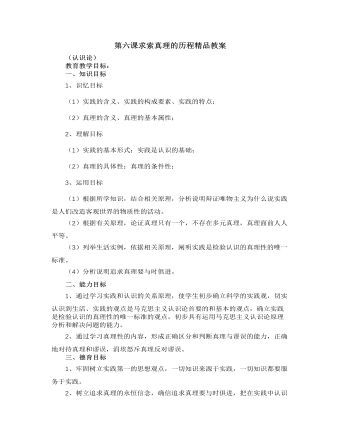
人教版高中政治必修4第六课求索真理的历程精品教案
二、分析题基于非典型肺炎防治的需要,武汉大学和中国科学院微生物研究所,集中优秀人才和先进的仪器设备,以科学的理论为指导,运用现代的知识与技术手段,对SARS病毒进行深入细致的研究。2003年5月,他们联合研制出抗击SARS病毒侵入细胞的多肽药物。经科学试验证明,它可以阻断SARS病毒侵入人体细胞,具有预防和治疗两种功效。这些药物的发明在非典型肺炎的预防和治疗发挥着重要的作用。上述材料体现了辩证唯物主义认识论的哪些观点?答案提示:体现了实践是认识的来源、实践是认识发展的动力、实践是检验认识的真理性的唯一标准、实践是认识的目的和归宿、认识对实践具有反作用等辩证唯物主义认识论的观点。三、辨析题1、“仁者见仁,智者见智”的说法否定了真理的客观性答案提示:(1)此观点错误。(2)“仁者见仁,智者见智”是说对同一事物不同的人有不同的见解。
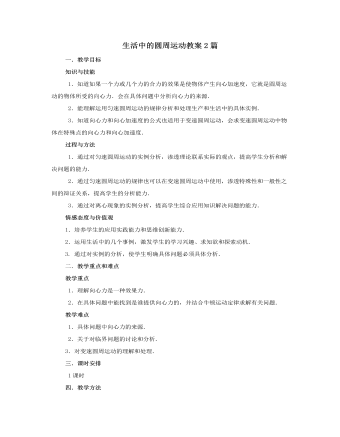
人教版新课标高中物理必修2生活中的圆周运动教案2篇
思考:洗衣机脱水时转速高时容易甩干衣物,还是转速低时容易甩干衣物?(2) 制作棉花糖的原理内筒与洗衣机的脱水筒相似,里面加入白砂糖,加热使糖熔化成糖汁。内筒高速旋转,黏稠的糖汁就做离心运动,从内筒壁的小孔飞散出去,成为丝状到达温度较低的外筒,并迅速冷却凝固,变得纤细雪白,像一团团棉花。5.离心现象的防止在水平公路上行驶的汽车,转弯时所需的向心力是由车轮与路面的静摩擦力提供的。如果转弯时速度过大,所需向心力F大于最大静摩擦力Fmax,汽车将做离心运动而造成交通事故。因此,在公路弯道处,车辆行驶不允许超过规定的速度。当高速转动的砂轮或者飞轮内部分子间相互作用力不足以提供所需向心力时,离心运动就会使他们破裂,甚至酿成事故。
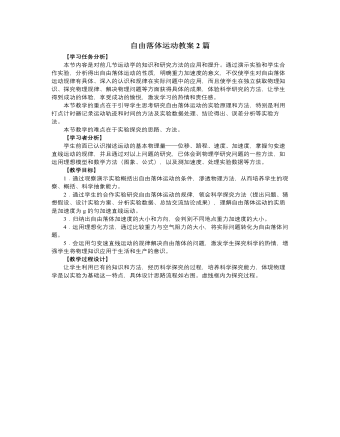
人教版新课标高中物理必修1自由落体运动教案2篇
教学重点1.自由落体运动的概念及探究自由落体运动的过程。2.掌握自由落体运动规律,并能运用其解决实际问题。教学难点演示实验和探究实验的技巧及自由落体运动规律的得出.教学过程设计思想:1、 先用游戏激发学生学习兴趣,顺理成章地研究落体运动;2、 通过演示实验让学生自己总结出物体下落快慢不同的主要原因是空气阻力,从而猜想若没有空气阻力会怎样;3、 用牛顿管实验验证猜想,引入了新的理想运动模型:自由落体运动。讲述1971年宇航员做的实验,加深印象;4、 了解地球表面物体下落运动近似成自由落体运动的条件;5、 着手研究自由落体运动的规律,利用打点计时器进行研究,得到结论;6、 总结自由落体运动特点及重力加速度;7、 应用训练
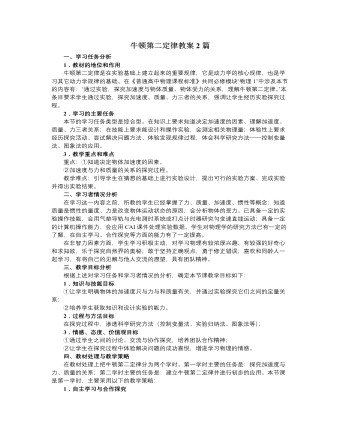
人教版新课标高中物理必修1牛顿第二定律教案2篇
1.这节课以实验为依据,采用控制变量的方法进行研究。这一方法今后在电学、热学的研究中还要用到。我们根据已掌握的知识设计实验、探索规律是物体研究的重要方法。2.定义力的单位“牛顿”使得k=1,得到牛顿第二定律的简单形式F=ma。使用简捷的数学语言表达物理规律是物理学的特征之一,但应知道它所对应的文字内容和意义。3.牛顿第二定律概括了运动和力的关系。物体所受合外力恒定,其加速度恒定;合外力为零,加速度为零。即合外力决定了加速度,而加速度影响着物体的运动情况。因此,牛顿第二定律是把前两章力和物体的运动构成一个整体,其中的纽带就是加速度。四、评价方案及说明1、对科学知识与技能的评价要注重科学内容的理解与应用,而不是单纯记忆。技能的评价目标包括观察技能、实验技能等方面。对科学的技能的评价要尽量融合在科学探究过程的情景中。对科学知识的评价主要从两方面,一是根据学生诊断性练习;二是通过学生作业反映学生掌握情况。